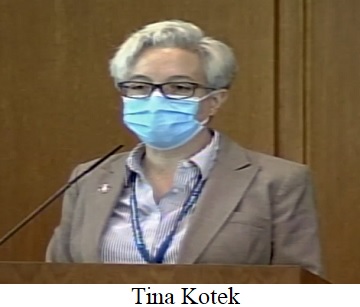Kids Get Penalized When Adults Play Politics
Editor's note: This article appeared as a blog on the Oregonians for Liberty in Education site and is reprinted here, with permission.
After a COVID-19
timeout this week at the Capitol, the clock is running down on lawmakers, led by Democratic House Speaker Tina Kotek, to agree on new congressional and state legislative district boundaries by Monday.
As a result of the 2020 census, Oregon will gain a sixth seat in the U.S. House of Representatives. “PlanScore, a nonpartisan online tool that analyzes redistricting proposals for partisan bias, suggests the congressional map Democrats are hoping to pass is
heavily favored in their party’s interests.â€
As to state legislative boundaries, even before maps are redrawn, Democrats hold supermajorities–more than three-fifths of the seats–in both the House and Senate. The new maps are expected to further widen the disparity.
Why this matters for Oregon schools.
Democrat supermajorities mean education bills do not need bipartisan support. For example, on June 26, the final day of the last regular legislative session,
SB 225 passed 23 to 5 in the Senate, and
HB 2001 passed 20 to 8. These bills, and others enacted this session, are heavily influenced by left-leaning activists, the teachers union, the Oregon Department of Education, and Governor Brown’s office. It seems parents and students are getting short shrift.
SB 225 is about educational service district funding. But tucked into the legislation is the creation of a new statewide Task Force on School Safety, with membership appointed in part based on status as “historically, traditionally and currently disadvantaged or underrepresented groups.†The Task Force–which has some useful goals like developing a statewide database of school floor plans for emergency responders–must use an “equity-driven approach,†and will look at standardizing school safety statewide, which could limit local control of school safety decisions including school resource officer staffing.
HB 2001 is also about school staffing and was
pushed by activist groups including
Oregon Partners for Education Justice. It requires a “school district that is making reductions in educator staff positions to retain the teacher with less seniority if the release of the teacher would result in a lesser proportion of teachers with cultural or linguistic expertise.†The underlying goal of the bill, evident in earlier drafts: diversity-ratios and race-based hiring practices.
Scrapping standards shortchanges students.
Other education bills passed during the regular session include
HB 2954, which “allows public charter schools to implement a weighted lottery that favors historically underserved students,†and
SB 744 which eliminated the essential skills test–reading and math proficiency–required to obtain an Oregon high school diploma.
A D V E R T I S E M E N T

A D V E R T I S E M E N T
SB 744 epitomizes the problems in Oregon public education today. The bill was promoted by the same group that pushed
HB 2001, Oregon Partners for Education Justice.
In a breathtaking display of irony, the group claimed that "with
SB 744, Oregon can ensure high school diplomas are rigorous, relevant, and truly reflect what every student needs to thrive in the 21st century."
As we
wrote in June: “Oregonians should be wary of activist groups claiming–without evidence–that removing requirements makes diplomas more “rigorous.†Removing requirements is not rigor. Rigor is not equity. And equity is not equality or excellence in education. Whether or not adults agree on vocabulary, the bottom line is that SB 744 uses equity as a euphemism for scrapping standards and shortchanging students.â€
 ODE prioritizes ideologies over academics.
ODE prioritizes ideologies over academics.
Over the last year, the Oregon Department of Education, under the direction of Colt Gill, has been busy issuing guidelines about quarantining kids and enforcing mask mandates. And they’ve continued to push ideologies over academics.
In June ODE paid $50K for two Nikole Hannah-Jones webinars, diverting funds from the Every Day Matters program aimed at addressing chronic school absenteeism. At that time we
wrote: “The May 7 webinar characterized America’s past as a 400-year-old system of oppression and America’s present as irredeemable due to the ‘legacy of slavery.’ One panelist insisted that ‘slavery hasn’t ended.’†Now local school districts are baking this New York Times-based worldview into their social studies and new “ethnic studiesâ€
curriculums.
A more recent example of ODE’s push for divisiveness in the classroom was its September 16
resolution “encouraging solidarity and support for student identities.†“The Board’s resolution calls on the Newberg School Board specifically to reverse course on its efforts to remove BLM and Pride flags from school settings.†Should we hold our breath for ODE to issue a resolution in support of Christian and pro-life identity symbols? Should we be concerned with ODE’s heavy-handed attack on local school boards and their common sense policies which are the last line of defense against the left-leaning ODE and Oregon legislature?
We’ll need to play the long game.
In their
editorial today, the Oregonian criticized the “Democrats’ anti-democratic power play†and called the redistricting “shamelessly gerrymandered.â€
So we won’t have a level playing field, but we’ll still need a game plan.
Parental awareness. School choice and alternative education options. Common-sense local leaders like Newberg School Board chair Dave Brown. New leadership in Salem. Better curriculum for Oregon school children. Kids deserve to win.
--Mary Miller| Post Date: 2021-09-25 10:05:20 | Last Update: 2021-09-25 19:15:27 |








 ODE prioritizes ideologies over academics.
ODE prioritizes ideologies over academics.